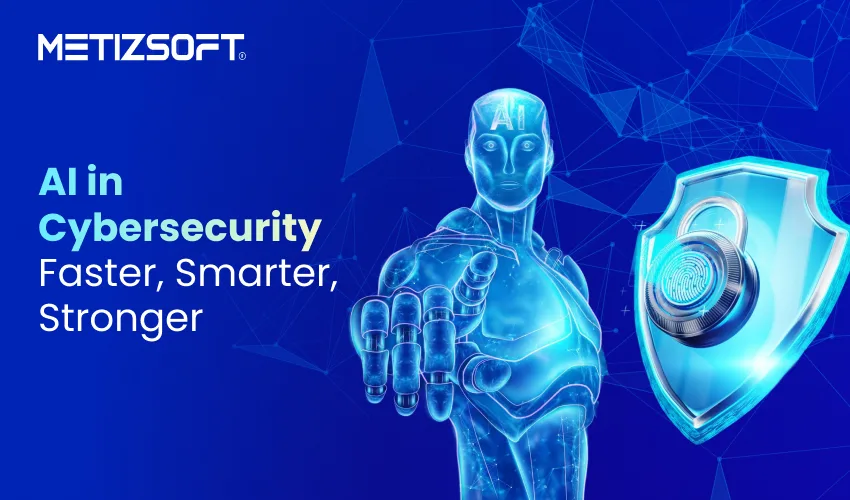
AI in cybersecurity is progressing exponentially amongst startups and enterprises worldwide. And why not? Cyber attackers are now moving at machine speed. Hence, defenders must quickly adapt AI cybersecurity to automate, scale, and learn continuously on how to prevent those emerging attacks.
This article shows you how AI strengthens modern cyber defenses, what tech powers it, where the real risks lie, and what to do about it, so you’re not left chasing yesterday’s threats.
Table of Contents
Introduction
We get conscious when we get a “suspicious alert” on our mobile. Now, multiply that by a thousand, and you will get a sense of what companies deal with every single day. The fact is, cyber threats are getting faster, smarter, and sneakier than ever. (eCommerce Security: What You Must Do)
Today, entire attack campaigns run automatically, powered by bots and scripts that never sleep. And to tackle that, organizations are now adopting AI cybersecurity. They are not doing it to replace humans; they are giving defenders superpowers. AI helps them see what others miss, connect dots across millions of signals, and even stop attacks before they start.
Why AI Is Important in Modern Security?

- Predictive Analytics: Instead of waiting for a breach, AI uses historical and real-time data to flag where trouble is likely to hit. For example, if you see credential misuse followed by unusual lateral movement, AI can pre-warn you.
- Enhanced Accuracy: Anyone who’s worked in security knows the pain of false alarms. AI’s behavioral smarts cut through that noise, focusing your team’s attention where it actually matters: the real threats hiding in plain sight.
- Speed and Scalability: Defense operations can’t rely solely on manual. One report found that 95% of cybersecurity professionals believe AI cybersecurity solutions significantly boost prevention, detection, and response.
- Continuous Learning: Threats evolve. The models that guard today need to adapt for tomorrow. When your system learns from each incident, your defenses grow stronger. Without it, you’re always catching up.
How AI Enhances Threat Detection?
You are the CEO of a medium-sized enterprise. You’ve got hundreds of servers, thousands of devices, countless data flows, and logs coming in by the second. Human analysts can’t possibly keep up with every anomaly. That’s where machine learning, cyber threats, and automated defenses come to the rescue.
- Real-Time Monitoring: You wouldn’t rely on a once-a-day guard walk. You’d want motion sensors inside, cameras streaming live, and alerts when something’s off; that’s exactly what AI does for networks and endpoints. Instead of waiting for a human to spot odd behavior, AI watches 24/7 across logs, flows, and device telemetry.
- Behavioral Analysis and Anomaly Detection: Let’s say your office boy always comes in from the back door between 8:30 and 9:15 p.m. One day, someone logs in at 3 a.m. to their account and downloads large volumes of data. That’s weird, right? AI models are trained to spot “that’s weird” and flag it, even if there’s no known signature for this attack.
- Identifying Patterns and Correlations: Often, one event by itself doesn’t scream “breach.” Credential reuse, odd external connections, and data extraction attempt to link these dots. One vendor study found organizations using AI tools sped up containment by over 100 days.
Types of AI Technologies Used in Cybersecurity
Machine Learning (ML)
Machine learning remembers every tiny detail and then uses it to predict what’s coming next. In cybersecurity, ML helps systems distinguish normal traffic from suspicious traffic. It’s how your network starts to recognize trouble before it happens.
Natural Language Processing (NLP)
NLP does everything at a machine scale. It reads text — like phishing emails, chat logs, or social engineering messages — and looks for tone, intent, or suspicious phrasing. So, whenever you get an email from your CEO at odd hours about sending money or letting you work on a secret project, and your senses hint that it could be wrong. Don’t respond quickly; NLP will handle it.
Deep Learning
Deep learning is a branch of machine learning. It works with huge, messy data — billions of signals, user actions, and network logs — and somehow finds patterns that humans would never notice. In cybersecurity, it helps uncover complex attack chains and “low and slow” intrusions that creep in over weeks.
Neural Networks
Neural networks, when trained properly, become incredibly good at recognizing images, voices, and behavioral patterns. In cybersecurity, neural networks can detect unusual login attempts, spot fake user accounts, and even identify malware by analyzing its digital DNA.
How AI Prevents Cyber Attacks?
Most of us only hear about cybersecurity when something goes wrong, when a company’s been hacked, data’s leaked, or headlines scream “massive breach.” But AI cybersecurity doesn’t do damage control; it prevents the damage before it happens.
- Predictive Analytics: AI learns from every past attack, not just yours, but from thousands of others happening worldwide. It studies the “signs” that usually show up before a cyber incident. Like noticing the smell of smoke before a fire, AI picks up on those early warning signals and alerts your team before flames start flying.
- Automated Threat Hunting: AI doesn’t wait for an alert; it actively looks for suspicious activity buried deep in your systems. Maybe it’s a new login pattern or strange data movement, tiny things a human might overlook, but AI never does.
- Automating Response to Attacks: When something sketchy happens, AI doesn’t stop to ask for permission. It can automatically isolate an infected laptop, block a shady IP address, or pause a suspicious process, all in seconds. These automated defenses mean an attack can be stopped before it even makes the evening news.
- Smarter Endpoint Protection: Every phone, laptop, or tablet connected to your network is a potential cyber threat entry point. AI acts like a personal bodyguard for each one, learning what “normal” behavior looks like and jumping into action when something feels off.
According to IBM’s 2024 Security Report, AI-powered systems reduced breach costs by 27% and sped up containment times dramatically.
Challenges of Using AI in Cybersecurity
- AI Exploitation by Cybercriminals
Yes, the defenders have AI; the attackers do too. Threat actors generate convincing phishing emails, automate scans, and craft deepfake voices. One study found that 78% of CISOs say AI-powered threats are having a significant impact. So don’t treat AI like a silver bullet.
- Ethical Concerns
Black-box models, bias in training data, and lack of explainability. If your AI flags someone wrongly (say, a legitimate user as a threat), you have to ask: what’s the algorithmic logic? Humans must stay in the loop.
- Dependence on Data Quality
Garbage in, garbage out. If your data is partial, noisy, or biased, your AI model will be too. And you’ll compound risk rather than reduce it.
- High Implementation Costs
Tools, infrastructure, skilled people, and culture change. Only 37% of organizations have processes to assess the security of AI tools before deployment. If you rush implementation, you might inadvertently expose new vulnerabilities.
Future of AI in Cybersecurity
- Enhanced Collaboration Between AI and Human Analysts: The goal is synergy; the AI handles noise, and humans handle nuance. A recent study shows humans working with AI made fewer mistakes in intrusion detection than humans alone.
- AI-Powered Threat Intelligence: Shared models, cross-organization learning, and dynamic ecosystems where you benefit from collective “experience.”
- AI-Assisted Autonomous Response: We’ll see more playbooks where AI executes the first few actions (e.g., isolate the device, revoke credentials) and escalates to humans for complex tasks.
- Quantum Computing and AI in Cybersecurity: Quantum will challenge encryption standards; AI will be critical in adapting defense models. If you’re planning five-plus years ahead, this isn’t science fiction.
Wrapping It Up
Long gone are the days when cybersecurity focused primarily on firewalls and passwords. Nowadays, it is more about anticipation, quick response, and flexibility. AI is a game-changer for defenders, as it not only handles mundane tasks but also detects what human eyes cannot and learns from each mistake.
However, this is still a collaborative effort. Humans are still needed for their ability to judge, to be creative, and to apply ethics. The machines support them with their great processing power. Done correctly, this partnership can ensure that you are always a step ahead of the modern threats.
If your goal is to improve your security, collaborate with an AI development company or hire AI specialists to proceed further.
FAQs
Is AI really necessary for cybersecurity?
Yes. Today, the volume and speed of attacks cannot be controlled manually. AI helps you react faster and better.
Can hackers also use AI?
Absolutely. Therefore, defenders must use it.
Will AI replace human analysts?
No way. It handles complex tasks, but people still make big decisions.
Is AI cybersecurity expensive?
It can be done, but you can start small. Many existing tools already use AI quietly in the background.
What’s the future of AI in security?
Smarter, more autonomous systems that collaborate with humans, not replace them.
AboutManthan Bhavsar
Related Posts
How Shopify’s AI Integration is Transforming E-Commerce Personalization
Table of Contents IntroductionThe Importance of Personalization for Shopify StoreShopify Integration with AI: How the Combo...
How to Build a Scalable AI Chatbot for Business: Best Practices, Solutions & Roadmap
Table of Contents SummaryIntroductionWhy Scalability Matters in AI Chatbot DevelopmentTypes of Chatbots: Rule-Based vs....
